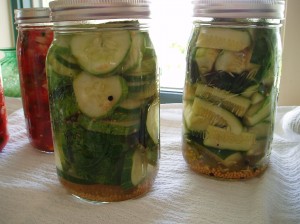Mankind has been preserving food for centuries. Much of the exploration of the world in which we live couldn’t have happened without that ability. Mariners especially needed preserved food for their voyages, as they couldn’t hunt and farm while crossing the ocean. The ability to preserve food freed these early explorers up from following the coastline, allowing them to travel great distances.
 While much of modern food preserving is done with chemicals, it wasn’t always that way. In ancient times, they had to depend on what nature provided for their preservatives. Fortunately, there are some excellent natural preservatives in nature, as well as a number of methods of preserving that make use of those natural preservatives. Probably the earliest form of preserving was drying food, especially grains. Archeologists find ancient tombs with grain in sealed clay jars, intended to feed the dead while they travel though the underworld. Some of these findings are literally thousands of years old.
While much of modern food preserving is done with chemicals, it wasn’t always that way. In ancient times, they had to depend on what nature provided for their preservatives. Fortunately, there are some excellent natural preservatives in nature, as well as a number of methods of preserving that make use of those natural preservatives. Probably the earliest form of preserving was drying food, especially grains. Archeologists find ancient tombs with grain in sealed clay jars, intended to feed the dead while they travel though the underworld. Some of these findings are literally thousands of years old.
Whereas grains are fairly easy to dry, meat and fruit are much harder. Many grains will dry on the stalk, meaning that it is harvested ready for long-term storage. As anyone knows, meats and fruits left out will spoil, making them useless or even dangerous for consumption. Rising to the challenge, our ancestors developed means of drying and preserving meats, fruits and vegetables. Interestingly enough, other than canning, these methods all require the use of either sugar or salt as a natural preservative. Smoking meats, for example, doesn’t preserve the meat, unless it is first soaked in brine, infusing the meat with a high salt concentration. While salt and sugar aren’t used to preserve the same types of food, they both work in the same way. Sugar is only used when preserving fruit, which already has a high sugar level. Meats are preserved with salt. The way that these two substances work is by removing water from the food. If you take a dish of fresh strawberries, cut them in half and sprinkle sugar on them and then leave them sit, the surface of the strawberries will become wet. That’s because the sugar is drawing the water out of the fruit’s cells. Salt does the exact same thing, when it is used for preserving meat.
Okay, so what does drawing the water out of food have to do with preserving it? Cells, whether plant cells, animal cells or bacteria are mostly water. If you draw enough moisture out of them, they can’t function properly and die. Since our food is already dead, that’s not an issue for us.But it is an issue for any bacteria that might be living in that food or try and attack that food. As long as the preserved food is still high in salt or sugar, the salt or sugar will draw the moisture out of the bacteria, killing it.While bacteria isn’t the only enemy our food has, it is the one which has the greatest probability of destroying the food, making it unfit for human consumption. It’s also the hardest enemy to protect food from. Insects and rodents can be kept out of food supplies by packaging; but protecting the food from bacteria requires that it is properly preserved.
Eat Tomorrow Foods has gone through rigorous testing to make sure our foods are fit for the long haul and provide you and your family food when you need it most. The modern Dry-Freezing process that we use ensures that the foods taste is not only locked in but that the nutrients are stored and held in the food. It’s been a real movement in technology that has allowed Food Storage to go from the ranks of what’s mentioned above to obtain over 25+ years of shelf life in today’s products, thus ensuring that you can purchase once but have a hearty meal at your beck and call whenever you might need it for a long period of time.
Prepare Today, Eat Tomorrow
 Eat Tomorrow Foods provide a safety against hunger and malnourishment. We are the provider of delicious and nutritious meals that are GMO Free and maintain a 25+ shelf life, providing you the peace of mind that when Emergency, Disaster, or the Unexpected take place your family will be provided for and prepared.
Eat Tomorrow Foods provide a safety against hunger and malnourishment. We are the provider of delicious and nutritious meals that are GMO Free and maintain a 25+ shelf life, providing you the peace of mind that when Emergency, Disaster, or the Unexpected take place your family will be provided for and prepared.
